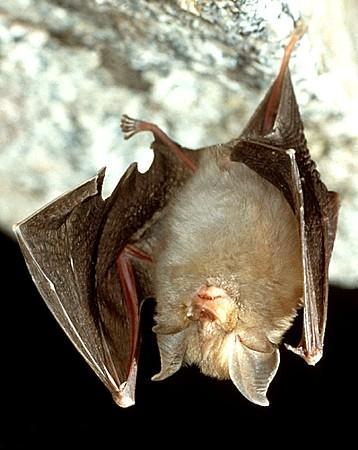- Lesser horseshoe bat
Taxobox
name = Lesser Horseshoe Bat

image_width = 200px
status = LC
status_system = iucn3.1
status_ref = [IUCN2006|assessors=Jacobs "et al"|year=2004|id=19518|title=Rhinolophus hipposideros|downloaded=11 May 2006 Database entry includes a brief justification of why this species is of least concern]
trend = down
regnum =Animal ia
phylum =Chordata
classis =Mammal ia
ordo =Chiroptera
familia =Rhinolophidae
genus = "Rhinolophus "
species = "R. hipposideros"
binomial = "Rhinolophus hipposideros"
binomial_authority = (Bechstein,1800 )The Lesser Horseshoe Bat ("Rhinolophus hipposideros"), is a type of
Europe anbat related to but smaller than its cousin, theGreater Horseshoe Bat . The species gets its name from its distinctivehorseshoe -shaped nose.Physical description
The Lesser Horseshoe Bat is one of the world's smallest bats, weighing only 5 to 9 grams, with a wingspan of 192-254 mm and a body length of 35-45 mm. It has strong feet that it uses to grasp rocks and branches, and can see well in spite of its small eyes. Like most bats, Lesser Horseshoe Bats live in colonies and hunt their prey by
echolocation , emittingultrasound from specialized round pads in their mouth.The base of its fur, which is soft and fluffy, is light grey in colour, with dorsal side fur smoky brown and the ventral side grey, with the exception of juvenile bats which are entirely dark grey. Ears and wing membranes are a light greyish-brown.
When hunting they are quick and agile, often flying within five metres of the ground while avoiding contact with bushes and shrubs. The Lesser Horseshoe Bat eats small insects, most of which are gleaned from stones and branches. Their favorite types of
prey include flies,moths , andspiders .Mating
Lesser Horseshoe Bats mate in the
autumn . Females give birth to one pup, normally between mid-June and the beginning of July. Pups weigh around 1.8 grams at birth, opening their eyes after around 10 days and becoming independent at six to seven weeks of age. The bats hibernate during the winter months in dark caves, mines, old buildings, and sometimes in cellars.Females becomesexually mature within their first year, with a study in Czechoslovakia showing that about 15% of females give birth at one year of age. Animals have been seen to chase each other as a preliminary to mating, which is done with the male hanging himself behind and over the female.
Nurseries are often shared with other species, such as the
Greater mouse-eared bat , but there is no direct mixing with other species. The move to nurseries occurs from april onwards, with between 10 and 100 females present and between 2 and 20 males. Approximately two thirds of females in a nursery roost give birth between mid-june and mid-july.Habitat
The Lesser Horseshoe Bat lives in warmer regions in foothills and highland, particular wooded areas or areas of limestone. In summer its habitats have been recorded up to 1160m above sea level, and up to 2000m in the winter, with the highest known nursery roost at 950m. The species are sedentary, with the average movement between summer and winter roosts between 5 and 10 kilometers, although the longest recorded distance is 153 kilometers.
This species is in decline due to a number of factors, including the disturbance or destruction of roosts, changes in
agricultural practices (such as the increased use ofinsecticide s, which reduce prey availability) and the loss of suitable foraging habitats.Echolocation
The frequencies used by this bat species for echolocation lie between 93-111 kHz, have most energy at 110 kHz and have an average duration of 31.7 ms. [Parsons, S. and Jones, G. (2000) 'Acoustic identification of twelve species of echolocating bat by discriminant function analysis and artificial neural networks.' "J Exp Biol"., 203: 2641-2656.] [Obrist, M.K., Boesch, R. and Flückiger, P.F. (2004) 'Variability in echolocation call design of 26 Swiss bat species: Consequences, limits and options for automated field identification with a synergic pattern recognition approach.' "Mammalia"., 68 (4): 307-32.] Due to the frequency of their echolocation calls there are overlaps with those of the
Mediterranean Horseshoe Bat andMehely's Horseshoe Bat .References
*cite book|last=Schober|first=Wilfried|coauthors=Eckard Grimmberger|title=A Guide to Bats of Britain and Europe|editor=Dr. Robert E. Stebbings|publisher=Hamlyn Publishing Group|location=UK|date=1989|edition=1st|isbn=0-600-56424-x|language=English
External links
* [http://www.arkive.org/species/ARK/mammals/Rhinolophus_hipposideros/ ARKive] Photographs, Video.
Wikimedia Foundation. 2010.
